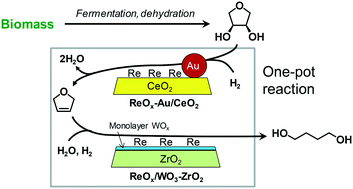Tungsten–zirconia-supported rhenium catalyst combined with a deoxydehydration catalyst for the one-pot synthesis of 1,4-butanediol from 1,4-anhydroerythritol†
Abstract
Efficient and reusable catalysts were developed for one-pot reduction of 1,4-anhydroerythritol (1,4-AHERY), which is a promising biomass-derived C4 platform chemical, into 1,4-butanediol (1,4-BuD) with H2. First, various ReOx catalysts on oxide supports were tested for reductive conversion of 2,5-dihydrofuran (2,5-DHF) to 1,4-butanediol (1,4-BuD). ReOx/WO3–ZrO2 showed the best performance, and ReOx catalysts supported on other oxides were much less active in the isomerization of 2,5-DHF to 2,3-DHF which is the first step of the 2,5-DHF conversion to 1,4-BuD. The ReOx/WO3–ZrO2 catalyst was combined with the ReOx–Au/CeO2 catalyst for deoxydehydration (DODH) of 1,4-AHERY into 2,5-DHF to develop a one-pot conversion system of 1,4-AHERY to 1,4-BuD. The highest 1,4-BuD yield of 55% from 1,4-AHERY was obtained. Even though the yield was lower than that obtained over the combination of ReOx/C and ReOx–Au/CeO2 catalysts in our previous study, the regeneration of the combination of ReOx/WO3–ZrO2 and ReOx–Au/CeO2 is possible: calcination at 573 for 3 h of the used catalyst mixture increased the activity to the fresh level. THF was the major by-product in both 1,4-AHERY and 2,5-DHF conversions, which was due to hydrogenation of DHF, disproportionation of DHF and/or dehydration of 1,4-BuD. The W amount in WO3–ZrO2 greatly affected the catalytic performance of ReOx/WO3–ZrO2: too much W above the monolayer level on the ZrO2 support sharply decreased the activity in 2,5-DHF isomerization. On the other hand, WO3–ZrO2 with a tetragonal ZrO2 structure prepared by co-precipitation showed comparable performance to WO3–ZrO2 with a monoclinic ZrO2 structure as the support of the ReOx catalyst, demonstrating that the crystal structure of ZrO2 has little effect on the catalytic performance. The Re species were suggested to be highly dispersed on the WO3 (sub)monolayer on ZrO2 based on the effect of the Re loading amount. The dispersed Re species on monolayer WO3 species on ZrO2 can be the active sites for 2,5-DHF disproportionation to 2,3-DHF.

- This article is part of the themed collection: Green Chemistry and Reaction Engineering


 Please wait while we load your content...
Please wait while we load your content...